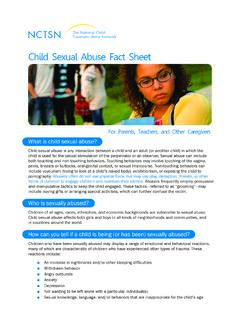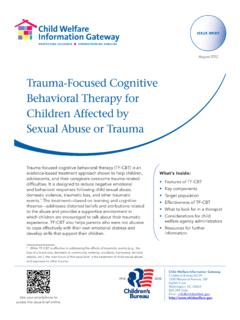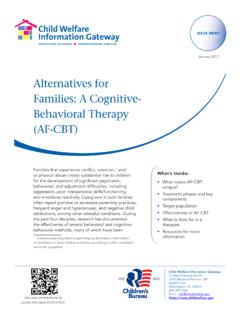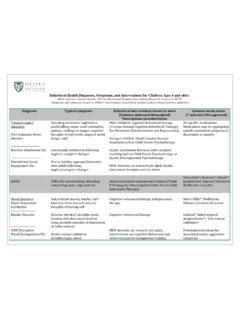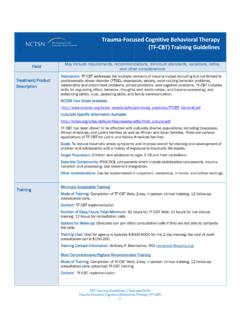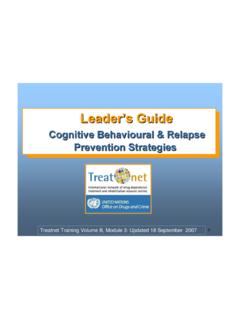Transcription of TF-CBT Treatment Components Summary PRACTICE
1 1 TF-CBT Treatment Components Summary PRACTICE P: Psychoeducation Therapists provide children and caregivers with education about the prevalence of traumatic events they may have experienced ( You are not alone ), normal reactions to trauma ( You are not weird or strange to feel these things ), and the benefits of effective Treatment ( You will get better ). Therapists seek to instill hope and positive expectations about the outcome of therapy . Psychoeducation is a first step of Treatment . Therapists immediately provide useful information and reinforce ideas frequently throughout the Treatment process. Goals: Psychoeducation helps to normalize responses by children and caregivers to traumatic events and support accurate cognitions about what occurred. Information provided may include: ! facts about different types of trauma and abuse (prevalence, frequency) ! common psychosocial and behavioral reactions following a trauma ! common symptoms and diagnosis related to traumatic events !
2 Why this type of trauma occurs ! why children may not like to talk about traumatic events ! offender motives ! issues related to abuse disclosure ! clarify myths and misinformation ! body awareness ! sex education Information provided to children varies according the types of traumatic events experienced and their age and developmental level. Providing children with accurate information helps to correct inappropriate information children may have been told by perpetrators or others, or came to believe on their own. Following a traumatic event, children and caregivers often feel confused, guilty, or crazy. Psychoeducation provides another way to target faulty or maladaptive beliefs by helping to normalize thoughts and feelings about the traumatic experiences. Psychoeducation also involves providing information about TF-CBT and the Treatment process. Most caregivers and children do not really know what to expect in therapy and some may have had poor experiences with the mental health system in the past.
3 Educating them about the topics such as the collaborative philosophy of TF-CBT , Treatment goals related to facing up to and resolving past traumatic experiences, and Treatment parameters such as duration, session length and structure, and therapy activities is critical to successful engagement. P: Parenting Skills Therapists teach caregivers effective parenting strategies to improve their ability to manage child behavior problems and increase functional behavior. Treatment targets often include disruptive, aggressive, and non-compliant behavior; fears; sleep problems; or inappropriate sexual behaviors. Providing caregivers with skills is important because common consequences of child victimization include disruptive, aggressive, and non-compliant behavior. Caregivers may feel guilty about disciplining children who have experienced traumatic events. Ver. 10/17/17 2 Goals: To decrease unhealthy, ineffective or unsafe techniques and increase use of positive, effective, and safe discipline strategies for child behavior problems.
4 When used correctly, these tools should increase positive behavior, decrease behavior problems, and improve the parent-child relationship. Some of the parenting skills typically taught to caregivers include: ! Importance of praise ! Use of selective attention and active ignoring ! Education about abilities at different developmental stages in order for the parent to have reasonable developmental expectations of the child ! Using behavior charts, contingency reinforcement programs and other effective reward and punishment techniques ! Appropriate use of Time-Out ! Importance of consistency, predictability, and follow through Therapists teach, assign, coach, and reinforce these parenting skills throughout Treatment . Therapists PRACTICE these skills with caregivers to prepare them to use these strategies effectively in the home, neighborhood, community, and elsewhere. R: Relaxation Therapists teach children and caregivers a set of relaxation skills to help them manage the physiological symptoms of fear and anxiety.
5 Having the body physiologically relax reduces children s perceptions of fear and anxiety and encourages a sense of empowerment, control, and mastery over symptoms. Goals: Enable children to use specific skills to reduce physiologic manifestations of fear, anxiety, stress, and physiological arousal. Therapists explain the body s responses to stress ( , shallow rapid breathing, rapid heartbeat, muscle tension, sweating, headache and body aches, stomach pain, butterflies ) and how relaxation works to counteract these bodily sensations. Therapists explain the difference between useful and adaptive fear and anxiety responses and unhelpful traumatic stress reactions. Therapists teach children specific methods of relaxation tailored to developmental level of child. Common relaxation skills may include: ! Focused or Controlled Breathing ( belly breathing ) ! Progressive Muscle Relaxation (PMR) ! Pleasant imagery ! Mindfulness or meditation skills !
6 Other calming activities ( , listening to relaxing music, creating relaxation songs, prayer) In conjoint sessions, children teach their caregivers the relaxation skills learned. children and caregivers PRACTICE and use the relaxation skills at home, in school, and elsewhere in between sessions. A: Affect Identification and Regulation children who have experienced traumatic events often experience intense levels of sadness, anger, fear, anxiety, guilt, shame, and disgust. They may have difficulties identifying, labeling, understanding, expressing, and effectively regulating their feelings, particularly negative feelings. Similarly, caregivers often experience a range of difficult emotions after their children have experienced traumatic events. They, too, may need help learning how to identify, label, express and regulate their own emotions in a healthy manner and how to help their children regulate their emotions. 3 Goals: To help children and caregivers learn the skills necessary to accurately identify, label, process, express, and regulate emotions, particularly negative emotions.
7 To help children and caregivers understand healthy vs. unhealthy or maladaptive forms of emotional expression. The therapist helps the child and caregiver understand and learn the basic skills of emotional regulation. These skills are applied to emotions associated with the abuse and other traumatic events. Teaching affect expression and modulation involves: ! Learning to correctly identify and label a range of positive and negative emotions to build an emotional vocabulary ! Understanding the causes and consequences of emotion ! Learning and practicing appropriate ways to express a range of feelings ! Identifying trauma-related feelings and learning strategies to manage these feelings ! Learning self-soothing techniques ! Learning how to increase the experience of positive emotions ! Enhancing social skills and problem solving C: cognitive Coping Therapists explain to children and caregivers the connections between thoughts, feelings, and behavior.
8 Many techniques are used to help them understand these connections and apply them to specific situations in their lives, including traumatic events. Goals: To teach children and caregivers methods for identifying specific thoughts that to distressing feelings and problematic behaviors. To teach them how to challenge inaccurate and unhelpful thoughts and replace them with accurate and helpful ones that lead to more positive feelings and functional behavior. Steps Involved: ! Therapists teach children and caregivers about the connections between thoughts, feelings, and behaviors. They often use an approach called the cognitive Triangle which visually depicts the relationships between thoughts, feelings and behaviors. ! children and caregivers learn how to identify thoughts associated with specific activating events in their lives, including traumatic events, and understand their connections to negative feelings and problem behaviors.
9 ! Therapists teach children and caregivers how to identify thinking mistakes. These are inaccurate, maladaptive, and unhelpful thoughts that lead to negative feelings and inappropriate behaviors. ! children and caregivers learn to challenge the thinking mistakes and replace them with accurate, helpful, and adaptive thoughts that lead to helpful and functional feelings and behaviors. Therapists teach children and caregivers to manage distressing thoughts using techniques such as: ! Getting accurate information, are thoughts true or false? ! Challenging negative thoughts and identifying alternative replacement thoughts ! Replacing challenged thoughts with helpful ones ! Building cognitive flexibility skills Therapists help children and caregivers develop the necessary skills to identify inaccurate or unhelpful thoughts, challenge them successfully, and generate alternative thoughts that are more accurate or helpful in order to feel differently.
10 All techniques should be adapted to the age and developmental skills of the children . Even very young children can distinguish between thoughts and feelings and understand the connection between them. 4 T: Trauma Narration and Processing Therapists help children create a story, or narrative, of the traumatic events that will help them approach rather than avoid memories, thoughts, and feelings associated with the traumatic experiences, process them and reduce trauma-related problems. Developing the trauma narrative is a form of gradual exposure therapy that allows children to experience repeatedly the negative feelings associated with the traumatic events in small doses in a safe, controlled, therapeutic environment. This process allows children to learn to experience, process, and reduce the negative thoughts and feelings associated with the traumatic events; resolve them; and incorporate them into their life. Therapists use a variety of techniques and structured activities to complete the Trauma Narrative, depending on the age, developmental abilities, and interests of children .
